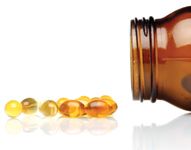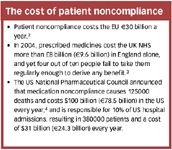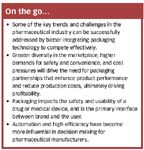The packaging connection
Pharmaceutical Technology Europe
Creating better pharmaceutical and medical products with packaging partnerships.
The pharmaceutical and medical product industries will witness a converging of trends in the next decade. For example, the global population is projected to rise from 6.5 billion in 2007 to 7.6 billion by 2020.1 Furthermore, the percentage of elderly people is rapidly increasing — predictions suggest the elderly population will increase from today's 7% to approximately 9% by 2020.1 A stronger focus on therapies rather than cures is set to continue, as is the growing need for anti-infectives as resistant strains continue to evolve. Additionally, there will be a greater need for antivirals as the world seeks to prevent the occurrence of pandemics. Some of these trends will present significant opportunities while others will pose new challenges.

However, all of these opportunities could be negated by the lack of laboratory productivity as nearly a third less drugs are being developed than 10 years ago.
Although the pharmaceutical industry will have to address this lack of laboratory productivity in the long term, packaging is a vital link to serving an expanded market with an ever shrinking pool of new drugs.

The cost of patient noncompliance
Pharmaceuticals and medical device manufacturing blur the lines between packaging and product more than any other market. Packaging impacts the safety and usability of a drug or medical device, and often serves as the primary interface with the patient or medical professional.
Trends in drug delivery, pharmaceuticals, nutraceuticals, biopharmaceuticals and vaccine development, coupled with cost pressures worldwide, have positioned packaging as an integrated process whereby automation and engineering partnerships are a necessity for medical and pharmaceutical device companies to compete effectively. This type of partnership can increase overall usability while increasing efficiency and reducing costs. Looking at some of the key trends in the medical and pharmaceutical industries, and outlining the role of packaging in each can help to better integrate packaging technology to improve profitability.
The lack of innovation in the laboratory has forced pharmaceutical companies to differentiate themselves in other ways; for example, through packaging. The decrease in the number of new medications, the rise in worldwide population and changing dynamics in the marketplace all affect how packaging is implemented and integrated into the global development, production and marketing of pharmaceuticals.
Redefining compliance and convenience
Convenience in the medical products market is determined by whether a product is easy to use and whether it encourages patient compliance (correct dosages, correct combinations of dosages, and the elimination of sterilization and verification).

On the go...
Single-use medical products are one growing area that illustrates the merger between packaging and product; for example, the move toward prefilled syringes for vaccines, heparin, cardiovascular products and new biotech drugs demonstrates how processing and packaging have merged into one seamless solution. Presterilized syringes are delivered in sealed plastic containers or tubs direct to the filling and packaging operation. The increasing numbers of suppliers of presterilized, readytofill syringes have given this segment stronger market shares compared with bulk syringes, which must be sterilized prior to filling.
During the years, syringe manufacturing technology has evolved, providing higher capacity and integrating several components into one system. For example, the Bosch FXS 5100 can fill and seal up to 36000 syringes/h, and has a fully automatic inline check weigher and an optional integrated isolator unit.
The demand for application and dosage control have led to a market growth of inhalers and needlefree injectors. These technologies rely on extremely fine powder that can be challenging to package and control. In addition, these devices are often tailored to administer only certain drugs or brands or drugs. Creating a system that can fill and assemble these devices, and seamlessly integrate them with primary and secondary packaging, helps increase the overall accuracy and efficiency of a packaging/manufacturing system.
Convenience is inextricably linked with patient compliance, which can have a significant impact on larger health trends. Convenient packaging, such as integrated instruction leaflet, timemarked blisters and easytocarry shapes and sizes, can improve patient compliance. This is particularly relevant given that the overthecounter market is set to grow as governments loosen regulations on pharmaceuticals that pose little threat if the incorrect dose is taken.
One example of convenient packaging is stick packs, which are conveniently sized and allow powdered healthcare products to be ingested directly by patients: a method favoured by many as it is easier and more pleasant than ingesting a product that has to be dissolved in water. Additionally, pharmaceutical wallets are a packaging style that combine the aforementioned aspects into one package, and are ideal for improving patient compliance. Another example of packaging that is both convenient and boosts patient compliance is Burgopak. This portable product provides integrated patient instructions, easy-to-open and close features and anticounterfeiting measures.
Safety from every angle
Safety is a key driver in most industries and is the primary goal in healthcare. Part of safety lies in patient compliance. However, processing medical products safely and accurately is also crucial to the safety of patients, as well as for those working in these manufacturing environments.
To increase accuracy, safety and efficiency, many packaging and processing applications integrate PAT. This FDA risk-based approach enables high efficiency and quality assurance in pharmaceutical manufacturing by introducing inspection and controlling systems throughout the entire process. This is known as closed loop control — nothing advances to the next step unless a problem is either fixed or a faulty element is rejected from the system.
PAT is important for ensuring product safety, but further automation and safety technologies, such as advanced isolation and automated cleaning technologies, are required to protect processing workers from harmful exposure to volatile substances such as oncology drugs, biopharmaceuticals and vaccines. These volatile substances are also rapidly growing markets; there are currently 245 pure vaccines and 11 combination vaccines in development. With fears of worldwide pandemics and large foundations funding vaccines on a global scale, this market is set to accelerate production.
The demand for barrier technology for aseptic filling lines, isolators and containments will also follow suit. These barrier technologies have been gaining wider acceptance in an effort to meet these growing trends for safety and compliance, and because FDA guidelines for aseptic manufacturing strongly recommend the use of such technologies. Although isolators and restricted access barrier systems (RABS) are not new technologies, the industry is rapidly adopting them as a result of improved validation experience.
Isolators are ideal for new integrated installations while RABS are more suited to preexisting installations. Both, however, offer greater safety for personnel working in the pharmaceutical industry and better quality control for the production of pharmaceuticals, biopharmaceuticals, and vaccines.
Integration in this area can be key. An integrated isolator and filler offers some advantages compared with two components from two suppliers; for example, in an integrated system, controls are integrated as is the knowledge base behind the system. If the system has to be serviced or changed, the integration of the two components is more easily understood and resolved.
An increasing trend in the pharmaceutical and medical device markets is product diversity. For scientific and social reasons, such as a movement toward more potent and toxic treatments as well as a demand for greater convenience, discretion and mobility on the part of the patient, these markets have presented more complex and diverse pharmaceutical and medical product solutions. The packaging supply chain is following suit. For example, some medicines, such as cytotoxic agents and hormones, require minimal doses because they are highly potent. These drugs have a higher risk of crosscontamination from harmful dust exposure and powders can vary slightly in density. These factors have led to a rising trend in liquidfilled capsules.
From a packaging/processing standpoint, technological evolution to meet this product diversity trend is vital, and new innovations have streamlined production and increased quality; for example, liquid encapsulation micro spray (LEMS) has simplified closure of hard gelatin capsules by spraying a solution of ethanol and water on the body and cap overlap, eliminating the need for banding. Degassing is another development that prevents bursting after the closing procedure. This process divides the closing into two steps allowing positive pressure to escape before the final closing occurs.
Anticounterfeiting is also an important element of safety. The market for pharmaceuticals in E7 developing nations is set to grow from $518 billion (€416.2 billion) in 2006 to more than $800 billion (€642.7 billion) in 2020,1 but counterfeits could threaten this growth. The many anticounterfeiting measures available through packaging technology are a wise investment to maximize growth in this sector.
Packaging push back
Cost pressures on the marketplace are a result of greater competition from low-cost overseas suppliers, higher material prices, and increasing demands for more features and greater convenience. In addition, many government initiatives to drive down costs are on the horizon in Europe and in the US. Administrative costs account for the highest single cost in most healthcare systems — as high as 30% in the US while prescription drugs account for only 10%. Be that as it may, Big Pharma remains a major target in the mindset of political leadership and the public, and cost-cutting measures are likely.
The packaging industry can reduce costs through efficiency. Greater automation and integration of packaging lines for medical and healthcare products is a direct, yet effective, way of reducing the total cost of operations while maintaining quality and innovation. For example, Sigpack's stick pack solution can be linked directly to a cartoning machine from the same manufacturer. The entire system can pack stick packs in one or two lanes up to 1000/min. Various resources are available to ensure this type of entire-line integration — filling and processing, to primary packaging (e.g., cartons and blisters), all the way to secondary and third degrees of packaging (e.g., cartoners and case loaders) — is expertly integrated from a single source responsible for the entire line's efficient operation.
Working with a single supplier is a good way to seamlessly integrate a line. The resources of a single supplier allow companies to leverage the collective knowledge of the organization and create solutions that are focused on end results; not on the operation of a single machine. In addition, other resources within the company may be available that can streamline automation.
Another component of efficiency is in material savings. Reducing use of materials is key to lower costs and has the added benefit of having a positive impact on the environment. Packaging technology plays a large part in saving materials; for example, stick packs can save 20–40% material if used instead of the traditional packet.
Other packaging technologies can be adapted to use less material or alternative materials. Furthermore, packaging suppliers can often engineer solutions tailored to certain applications that can lead to more efficient uses of materials. An early partnership with packaging machinery manufacturers can help convey a better understanding of end-user needs and material reduction demands. Creating technology to accommodate these factors is more likely with an early partnership in place.
Integration key — partnership essential
Packaging will play a more important role in differentiating medical products in the market as competition among existing products increases. Because of greater diversity in the marketplace, higher demands for safety and convenience, and greater cost pressures from both the market and competition in lowcost countries, companies will increasingly need packaging partnerships that enhance product performance and reduce the total cost of production.
To do this effectively, medical device manufacturers and drug producers must bring packaging technology into product development earlier to maximize its impact. Doing this can enhance overall product effectiveness, streamline processes and speed timetomarket.
The global market for medical products is growing as populations age, emphasis on therapies grow and emerging economies invest more in healthcare. However, an integrated approach to the entire supply chain can ensure that growth is possible safely and economically.
Holger Botsch is Product Management, Sigpack Systems (Switzerland).
Bernard C. Fenner is Vice President Packaging Systems, Business Unit Robotics and Secondary Packaging Product Lines.
Andreas Graf is Head of Industry Management Pharma, Medical & Healthcare, Sigpack Systems (Switzerland).
Jeff Jackson is Director Product Management and Marketing, Bosch — Pharma USA (Minneapolis, USA).
Markus Kurz is Vice President, Moeller & Devicon (Denmark).
Klaus Schreiber is Head of Product Management, Bosch — Pharma Liquid (Germany).
References
1 Pharma 2020: The vision; Which path will you take, PriceWaterhouseCoopers report (2007).
2. Addressing patient compliance: Targeted marketing driving a shift in focus from acquisition to retention, Datamonitor (23 August 2004).
3. "Non-compliance costs drug industry dear", DrugResearcher.com (6 September 2004).
4. Prescription Medicine Compliance, A Review of the Baseline of Knowledge — A Report of the National Council on Patient Information and Education (1995).

WMFTS’ BioPure to Showcase Single-Use Bioclamp with Refined Manufacturing at INTERPHEX 2025
April 1st 2025With advanced manufacturing, BioPure’s BioClamp connector is manufactured to be 13% lighter than the previous model, resulting in a 26% reduction in carbon dioxide emissions across the full lifecycle of the product.
Drug Solutions Podcast: A Closer Look at mRNA in Oncology and Vaccines
April 30th 2024In this episode fo the Drug Solutions Podcast, etherna’s vice-president of Technology and Innovation, Stefaan De Koker, discusses the merits and challenges of using mRNA as the foundation for therapeutics in oncology as well as for vaccines.